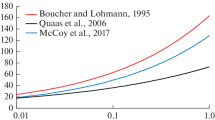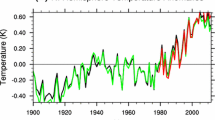Abstract
We intercompare a series of multi-year simulations with a coupled regionalchemistry-climate model for east Asia to assess the relative importance ofdirect and indirect (Type I) effects of anthropogenic sulfate on the climateof the region. Both direct and indirect aerosol effects induce a negativeradiative forcing that results in a cooling of the surface and in a decrease of precipitation. Under present day sulfur emissions,the direct aerosol effects prevail during the cold season, while the indirecteffects dominate in the warm season (when cloudiness is maximum over the region). When both the direct and indirect effects are included, the surface cooling varies in the range of –0.1 to over –1 K throughout the region and extended areas ofstatistically significant cooling are found in all seasons except winter.The indirect effects largely dominate in inhibiting precipitation, especiallyduring the summer. When doubling the sulfur emissions, the direct effects aresubstantially strengthened, while the indirect effects are only marginally affected. This indicates that the indirect effects over the region might be asymptotically approaching their maximum efficiency. Overall, the indirect effects appear necessary to explain theobserved temperature record over some regions of China, at least in the warm season.A number of uncertainties need to be addressed, such as due to Type IIindirect effects, modeling of the relationship between aerosol concentration and cloud optical properties, and contribution of aerosols other than anthropogenic sulfate.
Similar content being viewed by others
References
Barrie, L. A., Yi, Y., Leaitch, W. R., Lohmann, U., Kasibhatla, P., Roelofs, G. J., Wilson, J., Mc-Govern, F., Benkovitz, C., Melieres, M. A., Law, K., Prospero, J., Kritz, M., Bergmann, D., Bridgeman, C., Chin, M., Christensen, J., Easter, R., Feichter, J., Land, C., Jeuken, A., Kjellstrom, E., Koch, D., and Rasch, P. J.: 2000, ‘A Comparison of Large Scale Atmospheric Sulfate Aerosol Models (COSAM): Overview and Highlights’, Tellus 53B, 615–645.
Boucher, O. and Lohmann, U.: 1995, ‘The Sulfate-CCN-Cloud Albedo Effect: A Sensitivity Study with Two General Circulation Models’, Tellus 47B, 281–300.
Briegleb, B. P.: 1992, ‘Delta-Eddington Approximation for Solar Radiation in the NCAR Community Climate Model’, J. Geophys. Res. 97, 7603–7612.
Chameides, W. L.: 1995, The Yangtze Delta of China as an Evolving Metro-Agro-Plex. Proposal to the National Aeronautics and Space Administration, Georgia Institute of Technology, Atlanta, Georgia, 80302, U.S.A., p. 55.
Chameides, W. L., Kasibhatla. P. S., Levy, H., and Moxim, W. J.: 1994, ‘Growth of Continental Scale Metro-Agro-Plexes, Regional Ozone Pollution andWorld Food Production’, Science 264, 74–77.
Chameides, W. C., Li, X. S., Tao, X. Y., Zhou, X. J., Luo, C., Kiang, C. S., John, J. St., Saylor, R., Liu, S. C., Lam, K. S., Wang, T., and Giorgi, F.: 1999, ‘Is Ozone Pollution Affecting Crop Yields in China?’, Geophys. Res. Lett. 26, 867–870.
Chameides, W. L., Liu, S. C., Yu, H. B., Bergin, M., Zhou, X. J., Mearns, L. O., Gao, W., Kiang, C. S., Saylor, R. D., Luo, C., Huang, Y., Steiner, A., and Giorgi, F.: 1999, ‘A Case Study of the Effects of Atmospheric Aerosols and Regional Haze on Agriculture: An Opportunity to Enhance Crop Yields in China through Emission Controls?’, Proceedings of the National Academy of Sciences 96, 13626–13633.
Charlson, R. J., Langner, J., and Rodhe, H.: 1990, ‘Sulphate Aerosols and Climate’, Nature 348, 22.
Charlson, R. J., Schwartz, S. E., Hales, J. M., Coakley, R. D., Hansen, J. E., and Hoffman, D. J.: 1992, ‘Climate Forcing by Anthropogenic Aerosols’, Science 255, 423–430.
Giorgi, F.: 1989, ‘Two-Dimensional Simulations of Possible Mesoscale Effects NuclearWar Fires. I: Model Description’, J. Geophys. Res. 94, 1127–1144.
Giorgi, F. and Bi, X. Q.: 2000, ‘A Study of Internal Variability of a Regional Climate Model’, J. Geophys. Res. 105, 29503–29521.
Giorgi, F., Bi, X. Q., and Qian, Y.: 2000, ‘Direct Radiative Forcing and Regional Climatic Effects of Anthropogenic Aerosols over East Asia: A Regional Coupled Climate-Chemistry/AerosolModel Study’, J. Geophys. Res. 107 (D20), 4439, doi: 10.1029/2001JD001066.
Giorgi, F. and Chameides, W. L.: 1986, ‘Rainout Lifetimes of Highly Soluble Aerosols’, J. Geophys. Res. 91, 14367–14376.
Giorgi, F., Huang, Y., Nishizawa, K., and Fu, C. B.: 1999, ‘A Seasonal Cycle Simulation over Eastern Asia and its Sensitivity to Radiative Transfer and Surface Processes’, J. Geophys. Res. 104, 6403–6423.
Giorgi, F., Marinucci, M. R., and Bates, G. T.: 1993, ‘Development of a Second Generation Regional ClimateModel (RegCM2). Part I: Boundary-Layer and Radiative Transfer Processes’, Mon.Wea. Rev. 121, 2794–2813.
Giorgi, F., Marinucci, M. R., Bates, G. T., and De Canio, G.: 1993, ‘Development of a Second Generation Regional Climate Model (RegCM2). Part II: Convective Processes and Assimilation of Lateral Boundary Conditions’, Mon. Wea. Rev. 121, 2814–2832.
Giorgi, F. and Shields, C.: 1999, ‘Tests of Precipitation Parameterizations Available in the Latest Version of the NCAR Regional Climate Model (RegCM) over Continental U.S’, J. Geophys. Res. 104, 6353–6375.
Haywood, J. M. and Boucher, O.: 2000, ‘Estimates of the Direct and Indirect Radiative Forcing Due to Tropospheric Aerosols: A Review’, Rev. Geo. 38, 513–543.
Haywood, J. M., Roberts, D. L., Slingo, A., Edwards, J. M., and Shine, K. P.: 1997, ‘General Circulation Model Calculations of the Direct Radiative Forcing by Anthropogenic Sulfate and Fossil-Fuel Soot Aerosol’, J. Climate 10, 1562–1577.
Haywood, J. M. and Shine, K. P.: 1997, ‘Multi-Spectral Calculations of the Direct Radiative Forcing of Tropospheric Sulphate and Soot Aerosols Using a Column Model’, Quart. J. R. Meteorol. Soc. 123, 1907–1930.
Hegg, D. A.: 1994, ‘Cloud Condensation Nucleus-Sulfate Mass Relationship and Cloud Albedo’, J. Geophys. Res. 99, 25,903–25,907.
Jones, A., Roberts, D. L., and Slingo, A.: 1994, ‘A ClimateModel Study of Indirect Radiative Forcing by Anthropogenic Sulphate Aerosols’, Nature 370, 450–453.
Jones, A. and Slingo, A.: 1996, ‘Predicting Cloud-Droplet Effective Radius and Indirect Sulphate Aerosol Forcing Using a General Circulation Model’, Quart. J. Roy. Meteorol. Soc. 122, 1573–1595.
Kasibhatla, P., Chameides, W. L., and John, J. St.: 1997, ‘A Three-Dimensional Global Model Investigation of Seasonal Variation in the Atmospheric Burden of Anthropogenic Sulfate Aerosols’, J. Geophys. Res. 102, 3737–3759.
Kiehl, J. T. and Briegleb, B. P.: 1993, ‘The Relative Role of Sulfate Aerosols and Greenhouse Gases in Climate Forcing’, Science 260, 311–314.
Kiehl, J. T., Hack, J. J., Bonan, G. B., Boville, B. A., Briegleb, B. P., Williamson, D. L., and Rasch, P. J.: 1996, ‘Description of the NCAR Community Climate Model (CCM3)’, NCAR Technical Note, NCAR/TN-420 + STR, p. 152.
Kiehl, J. T., Schneider, T. L., Rasch, P. J., Barth, M. C., and Wong, J.: 2000, ‘Radiative Forcing Due to Sulfate Aerosols from Simulations with the National Center for Atmospheric Research Community Climate Model’, J. Geophys. Res. 105, 1441–1457.
Liousse, C., Penner, J. E., Chuang, C., Walton, J. J., Eddleman, H., and Cachier, H.: 1996, ‘A Global Three-Dimensional Model Study of Carbonaceous Aerosols’, J. Geophys. Res. 101, 19411–19432.
Lohmann, U. and Feichter, J.: 1997, ‘Impact of Sulfate Aerosols on Albedo and Lifetime of Clouds: A Sensitivity Study with the ECHAM4 GCM’, J. Geophys. Res. 102, 13685–13700.
Luo, C., St. John, J. C., Zhou, X. J., Lam, K. S., Wang, T., and Chameides, W. L.: 2000, ‘A Nonurban Ozone Air Pollution Episode over Eastern China: Observations and Model Simulations’, J. Geophys. Res. 105, 1889–1908.
Martin, G. M., Johnson, D. W., and Spice, A.: 1994, ‘The Measurements and Parameterization of Effective Radius of Droplets in Warm Stratocumulus Clouds’, J. Atmos. Sci. 51, 1823–1842.
Myhre, G., Stordal, F., Restad, K., and Isaksen, I. S. A.: 1998, ‘Estimation of the Direct Radiative Forcing Due to Sulfate and SSO Aerosols’, Tellus 50B, 463–477.
New, M. G., Hulme, M., and Jones, P. D.: 2000, ‘Representing Twentieth-Century Space Time Climate Fields. Part II: Development of a 1901-1996 Mean Monthly Terrestrial Climatology’, J. Climate 13, 2217–2238.
Penner, J. E., Charlson, R. J., Hales, J. M., Laulainen, N. S., Leifer, R., Novakov, T., Ogren, J., Radke, L. F., Schwartz, S. E., and Travis, L.: 1994, ‘Quantifying and Minimizing Uncertainty of Climate Forcing by Anthropogrnic Aerosols’, Bull. Amer. Meteorol. Soc. 75, 375–400.
Penner, J. E., Andreae, M., Annegarn, H., Barrie, L., Feichter, J., Hegg, D., Jarayaman, A., Leaitch, R., Murphy, D., Nganga, J., and Pitari, G.: 2001, ‘Aerosols, their Direct and Indirect Effects’, Chapter 5 of Houghton, J. T., Ding, Y. H., Griggs, D. J., Noguer, M., van der Linden, P. J., and Dai, X. X. (eds.), Climate Change 2001; The Scientific Basis, Contribution of Working Group I to the Third Assessment Report of the Intergovernmental Panel on Climate Change (IPCC), Cambridge University Press, Cambridge, U.K.
Qian, Y., Fu, C. B., and Wang, S. Y.: 1999, ‘Mineral Dust and Climate Change’, Adv. Earth Sci. 14, 391–394 (in Chinese).
Qian, Y. and Giorgi, F.: 1999, ‘Interactive Coupling of Regional Climate and Sulfate Aerosol Models over Eastern Asia’, J. Geophys. Res. 104, 6477–6499.
Qian, Y. and Giorgi, F.: 2000, ‘Regional Climatic Effects of Anthropogenic Aerosols? The Case of Southwestern China’, Geophys. Res. Lett. 27, 3521–3524.
Qian, Y., Giorgi, F., Huang, Y., Chameides, W. L., and Luo, C.: 2001, ‘Simulation of Anthropogenic Sulfur over East Asia with a Regional Coupled Chemistry-ClimateModel’, Tellus 53B, 171–191.
Ramaswamy, V., Boucher, O., Haigh, J., Hauglustaine, D., Haywood, J., Myhre, G., Nkajima, T., Shi, G. Y., and Solomon, S.: 2001, ‘Radiative Forcing of Climate Change’, Chapter 6 of Houghton, J. T., Ding, Y. H., Griggs, D. J., Noguer, M., van der Linden, P. J., and Dai, X. X. (eds.), Climate Change 2001: The Scientific Basis, Contribution of Working Group I to the Third Assessment Report of the Intergovernmental Panel on Climate Change (IPCC), Cambridge University Press, Cambridge, U.K.
Smith, S. J., Pitcher, H., and Wigley, T. M. L.: 2001, ‘Global and Regional Anthropogenic Sulfur Dioxide Emissions’, Global Planet. Change 29, 99–119.
Streets, D. G. and Waldhoff, S. T.: 2000, ‘Present and Future Emissions of Air Pollutants in China: SO2, NOx, and CO’, Atmos. Environ. 34, 363–374.
Twomey, S. A., Piepgrass, M., and Wolfe, T. L.: 1984, ‘An Assessment of the Impact of Pollution on Global Cloud Albedo’, Tellus 36B, 356–366.
Wang, W. X.: 1997, ‘The Issue of Environmental Acidification in China’, Acta Scientiae Circumstantiae 17, 15–23 (in Chinese).
Wigley, T. M. L.: 1989, ‘Possible Climate Change Due to SO2 Derived Cloud Condensation Nuclei’, Nature 339, 365–367.
Author information
Authors and Affiliations
Rights and permissions
About this article
Cite this article
Giorgi, F., Bi, X. & Qian, Y. Indirect vs. Direct Effects of Anthropogenic Sulfate on the Climate of East Asia as Simulated with a Regional Coupled Climate-Chemistry/Aerosol Model. Climatic Change 58, 345–376 (2003). https://doi.org/10.1023/A:1023946010350
Issue Date:
DOI: https://doi.org/10.1023/A:1023946010350




